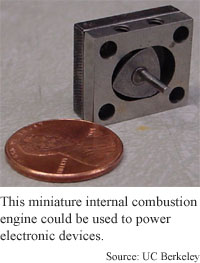
Engine
fires up electrical devices
By
Eric Smalley,
Technology Research NewsOn a plane trip in the not-too-distant future, the hum you hear coming from your seatmate's laptop computer might not be its hard drive but rather its power source.
Researchers at the University of California at Berkeley have developed an internal combustion engine that could replace batteries as the power source for portable electronic devices.
Though internal combustion engines are a decidedly 19th-century technology, the Berkeley engine's small size -- about the size of three stacked pennies -- opens up a new range of potential applications. The researchers are also building a still smaller micro engine from silicon components that could power microelectromechanical systems (MEMS).
The researchers' aim is to take advantage of the high energy density of liquid hydrocarbon fuels like butane, propane and gasoline to produce electrical and mechanical power for small-scale devices. A particular volume of a liquid hydrocarbon fuel can produce about thirty times as much energy as a battery of the same size, according to the researchers.
The mini engine will run for about two hours on one fluid ounce of fuel, and the micro engine could run for about 67 days on the same amount of fuel, said Aaron Knobloch, a graduate student at Berkeley.
"The long-term objective of this research is to develop a millimeter-scale rotary internal combustion engine that produces tens of milliwatts [of power]," he said.
The mini engine, which is made of steel and aluminum, turns at 3000 revolutions per minute and produces about half a watt of power. The engine weighs 22 grams, or about 4/5 of an ounce, and its combustion chamber measures 12.5 by 9.5 by 3.6 millimeters, said Knobloch.
Like the engine in your car, the mini engine works by igniting a mixture of fuel and air to create a series of small explosions. The Berkeley engine is a Wankel engine, which, instead of using the force of the explosions to drive pistons, uses it to spin a triangular rotor inside an oval chamber.
Of course, it remains to be seen whether people will be willing to trade changing batteries for loading flammable liquids into their laptop computers. "Safety is definitely a concern. However, we envision the engine, with its fuel, to be equivalent to a Bic lighter," said Knobloch, adding that people are allowed to carry butane lighters on airliners.
Batteries also have the advantage of not producing air pollution in their immediate environments. The main pollutant produced by combustion engines is carbon dioxide, which is a greenhouse gas.
"The mini engine produces as much carbon dioxide as one person at rest," or about one 400th the exhaust of an automobile traveling at 60 mph, said Knobloch. One hundred micro engines would produce the same amount of carbon dioxide as one mini engine, he added.
The researchers' next step is producing the prototype micro engine out of silicon and silicon carbide with the photolithography fabrication process used to make computer chips. The combustion chamber of the prototype will measure 3.3 by 3 by 1 millimeter, said Knobloch. The micro engine could be used to generate electricity and to drive small robots and other mechanical devices.
The mini engine could be used in practical applications within a couple of years, said Knobloch. The researchers expect to build a prototype of the micro engine within six months and aim to use it to power devices within four years, he said.
Knobloch's research colleagues were Carlos Fernandez-Pello, David Walther, Kelvin Fu, Fabian Martinez, Bryan Cooley and Dorian Liepmann of Berkeley, and Kenji Miyaska of Fukui University. They are scheduled to present their work at the 35th National Heat Transfer Conference in Anaheim in June. The research was funded by the Defense Advanced Research Project Agency (DARPA).
Timeline: < 2 years
Funding: Government
TRN Categories: Microelectromechanical Systems (MEMS)
Story Type: News
Related Elements: Technical paper, "Micro-Scale Combustion Research for Applications to MEMS Rotary IC Engines," 35th National Heat Transfer Conference, June 10-12, 2001, Anaheim, CA
Advertisements:
May 30, 2001
Page One
VR tool aims high
Bulk nanotubes make clean crystals
Engine fires up electrical devices
Microscopic stamps make nanotech devices
How metallic are metal nanotubes?

News:
Research News Roundup
Research Watch blog
Features:
View from the High Ground Q&A
How It Works
RSS Feeds:
News
Ad links:
Buy an ad link
| Advertisements:
|
 |
Ad links: Clear History
Buy an ad link
|
TRN
Newswire and Headline Feeds for Web sites
|
© Copyright Technology Research News, LLC 2000-2006. All rights reserved.